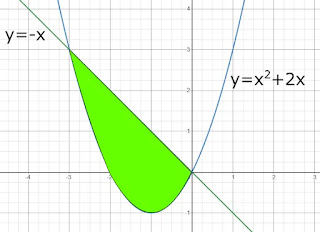Definite Integrals to Calculate Area
The Area Bounded by a Curve on the X-Axis
The area bounded by the curve $y = f\left( x \right)$ axis $X$, line $x = a$, and line $x = b$ is determined by:
- $L = \int\limits_a^b {f\left( x \right)} dx,\text{for }f\left( x \right) \ge 0$
- $L = - \int\limits_a^b {f\left( x \right)} dx,\text{for }f\left( x \right) \le 0$
The Area Bounded by Multiple Curves
The area bounded by the curve $y = f\left( x \right)$, $y = g\left( x \right)$, the line $x = a$, and $x = b$ is determined by formula:
\[L = \int\limits_a^b {\left[ {f\left( x \right) - g\left( x \right)} \right]} dx\]
Note that $f\left( x \right) \ge g\left( x \right)$ in closed intervals $a \le x \le b$.
Examples
Calculate the area bounded by the following curves using certain integrals
- The area bounded by the curve $y=2x$, the $X$ axis, the line $x=1$, and $x=3$.
- The area bounded by the curve $y = {x^2} + 2$, the axis $X$, the line $x=-1$, and $x=2$.
- The area bounded by the curve $y = - x$ and $y = {x^2} + 2x$.
- The area bounded by the curve $y = {x^2}$ and $y = {x^3}$.
Answer
- The area bounded by the curve $y=2x$, the $X$ axis, the line $x=1$, and $x=3$.
- The area bounded by the curve $y = {x^2} + 2$, the axis $X$, the line $x=-1$, and $x=2$.
- The area bounded by the curve $y = - x$ and $y = {x^2} + 2x$.
- The area bounded by the curve $y = {x^2}$ and $y = {x^3}$.
Take a look at the following graph:
From the graph above, at the interval $1 \le x \le 3$ the graph of the function $y=2x$ is above the $X$ axis. The area can be calculated as follows:
$\begin{array}{l} L &= \int\limits_1^3 {f\left( x \right)} dx\\ &= \int\limits_1^3 {2x} dx\\ &= \left[ {{x^2}} \right]_1^3\\ &= \left( {{3^2}} \right) - \left( {{1^2}} \right)\\ &= 9 - 1\\ &= 8 \end{array}$So, the area bounded by the curve $y=2x$, $X$ axis, line $x=1$, and $x=3$ is $8$ unit area.
Take a look at the following graph:
From the graph above, at the interval $-1 \le x \le 2$ the graph of the function $y = {x^2} + 2$ is above the $X$ axis. The area can be calculated as follows:
So, the area bounded by the curve $y = {x^2} + 2$, axis $X$, line $x=-1$, and $x=2$ is $9$ unit area.
Take a look at the following graph:
From the graph above, suppose $f\left( x \right) = y = - x$ and $g\left( x \right) = y = {x^2} + 2x$ then $f\left( x \right) \ge g\left( x \right)$ in the shaded area. To determine the upper and lower limits of the integration can be searched in the following way:
$\begin{array}{l} f\left( x \right) &= g\left( x \right)\\ \Leftrightarrow - x &= {x^2} + 2x\\ \Leftrightarrow {x^2} + 2x &= - x\\ \Leftrightarrow {x^2} + 2x + x &= 0\\ \Leftrightarrow {x^2} + 3x &= 0\\ \Leftrightarrow x\left( {x + 3} \right) &= 0\\ x = 0 \vee x + 3 = 0\\ x = 0 \vee x = - 3 \end{array}$We get the lower limit of $x = - 3$ and the upper limit of $x = 0$. The area can be calculated as follows:
So, the area bounded by the curve $y = - x$ and $y = {x^2} + 2x$ is $9$ unit area.
Take a look at the following graph:
From the graph above, suppose $f\left( x \right) = y = {x^2}$ and $g\left( x \right) = y = {x^3}$ then $f\left ( x \right) \ge g\left( x \right)$ in the shaded area. To determine the upper and lower limits of the integration can be searched in the following way:
$\begin{array}{l} f\left( x \right) &= g\left( x \right)\\ \Leftrightarrow {x^2} &= {x^3}\\ \Leftrightarrow {x^2} - {x^3} &= 0\\ \Leftrightarrow {x^2}\left( {1 - x} \right) &= 0\\ \Leftrightarrow {x^2} = 0 \vee 1 - x = 0\\ \Leftrightarrow x = 0 \vee x = 1 \end{array}$We get the lower limit of $x = 0$ and the upper limit of $x = 1$. The area can be calculated as follows:
So, the area bounded by the curves $y = {x^2}$ and $y = {x^3}$ is $\frac{1}{{12}}$ unit area.







Post a Comment for "Definite Integrals to Calculate Area"
Mohon untuk memberikan komentar yang baik dan membangun